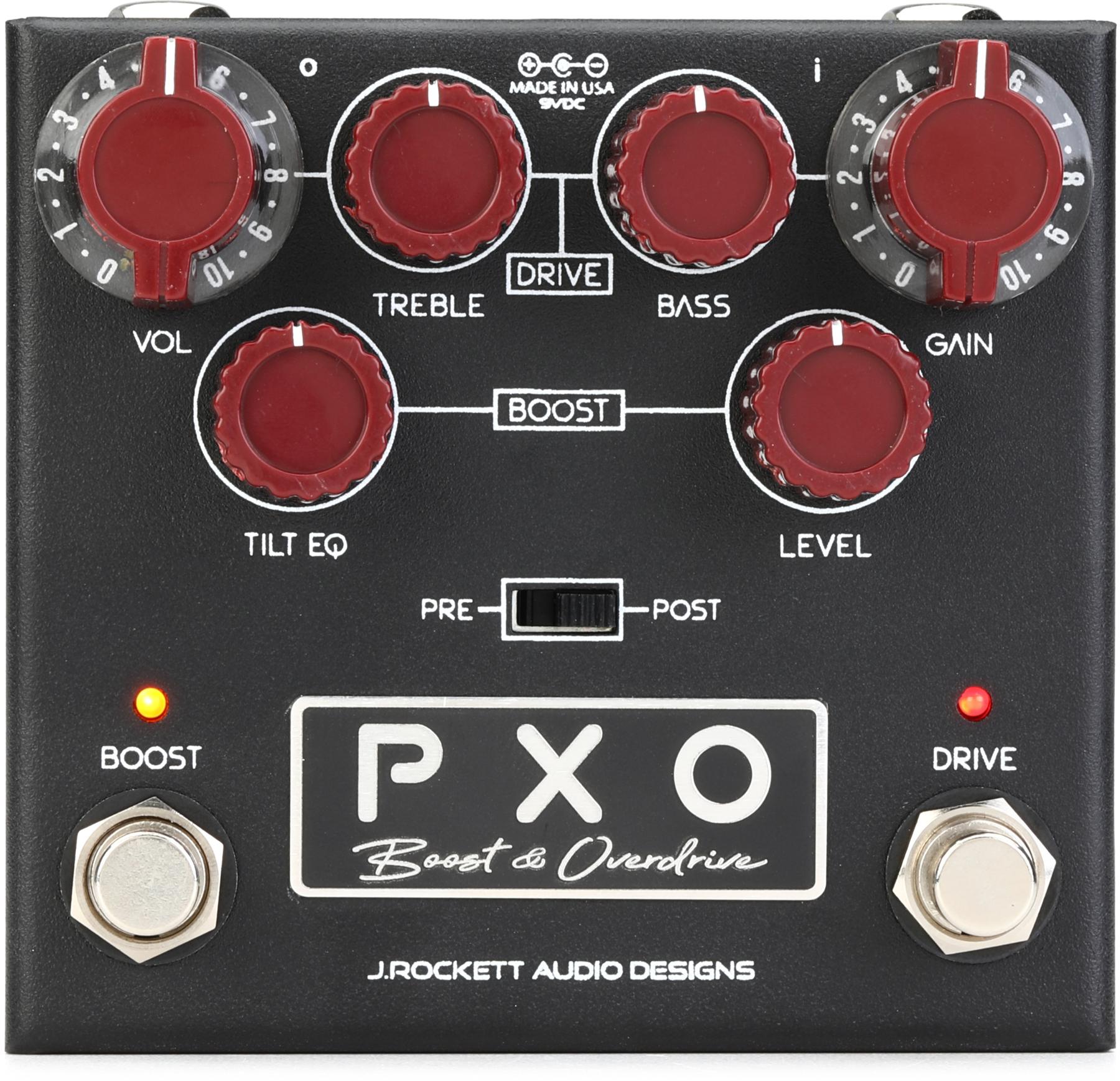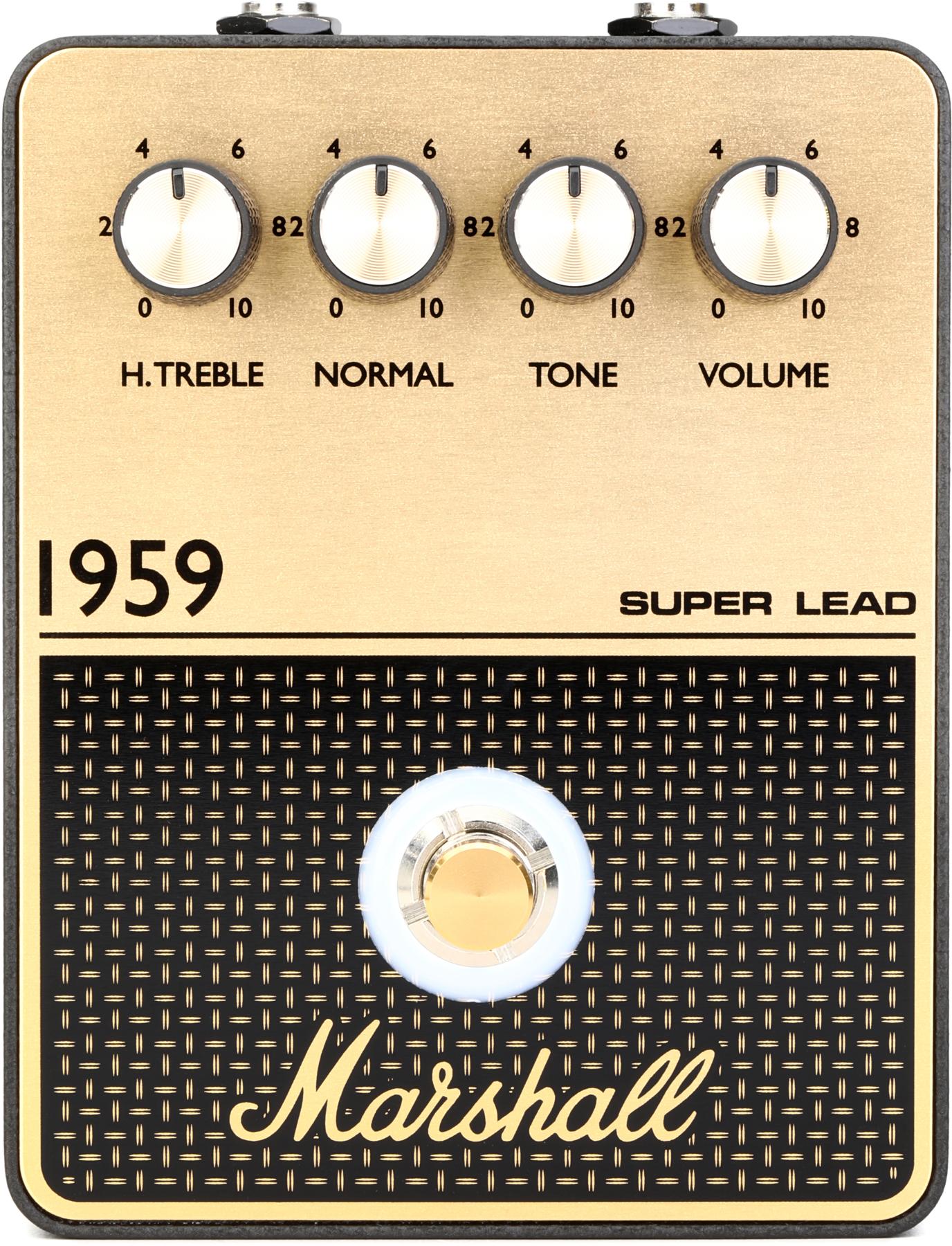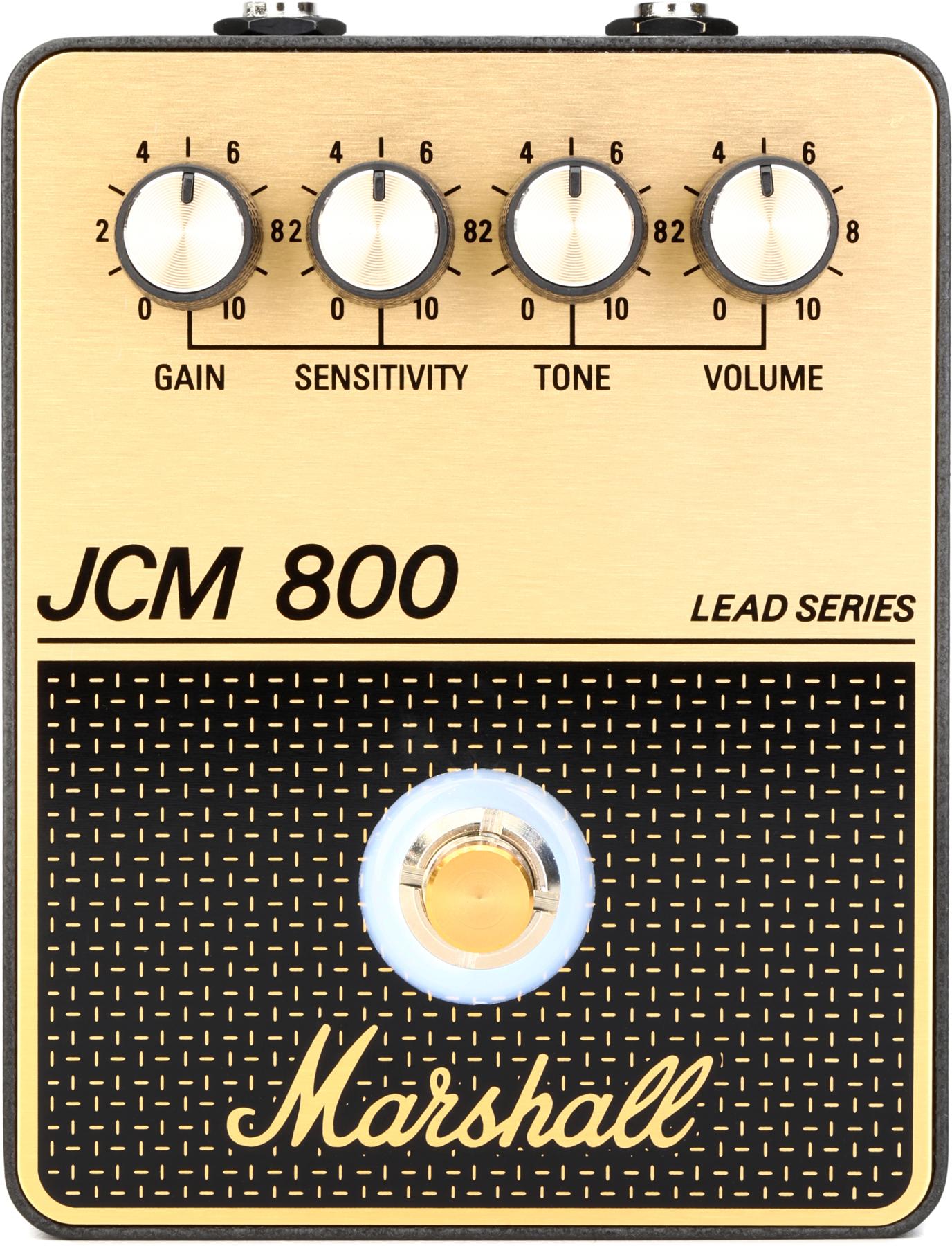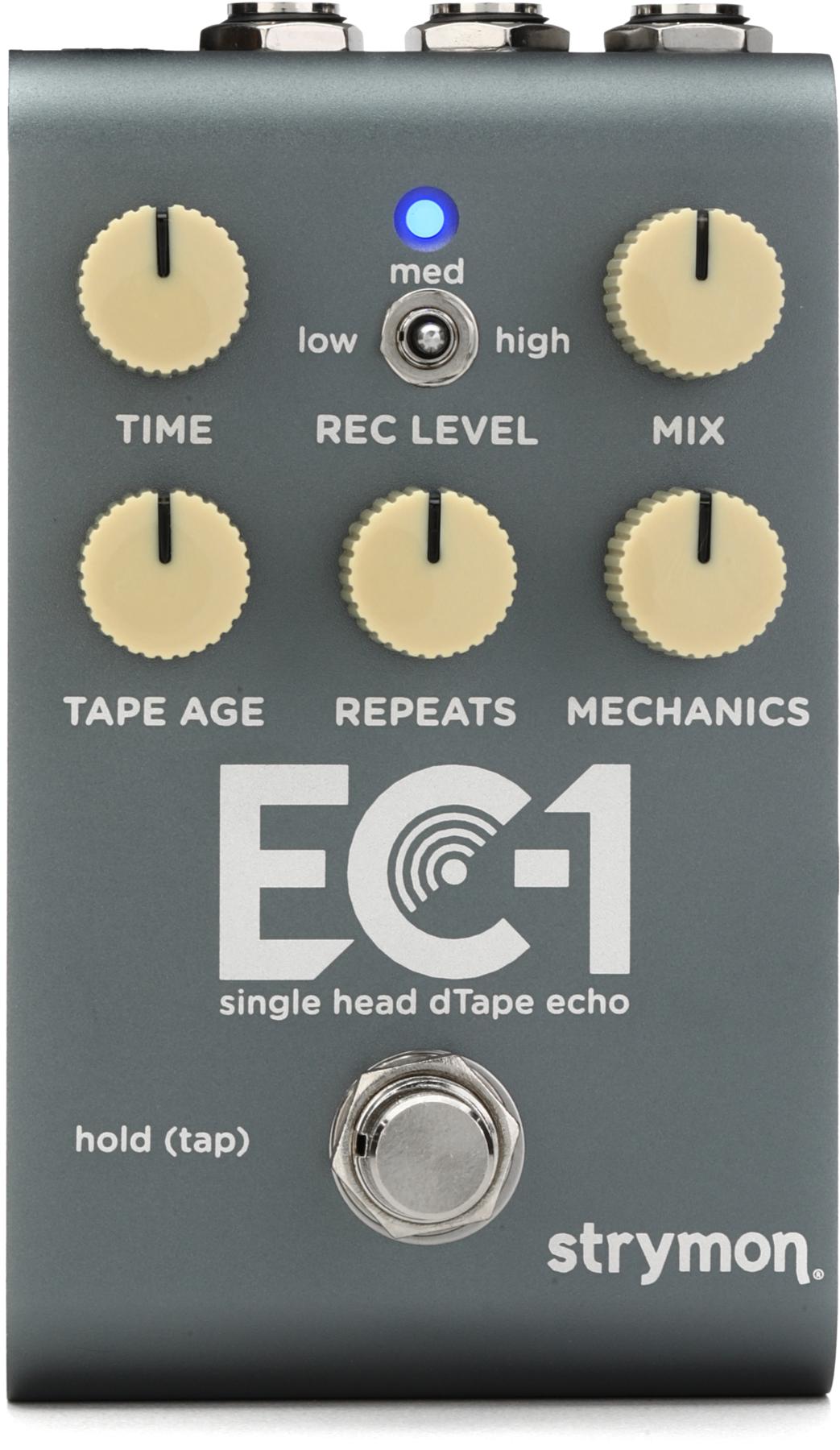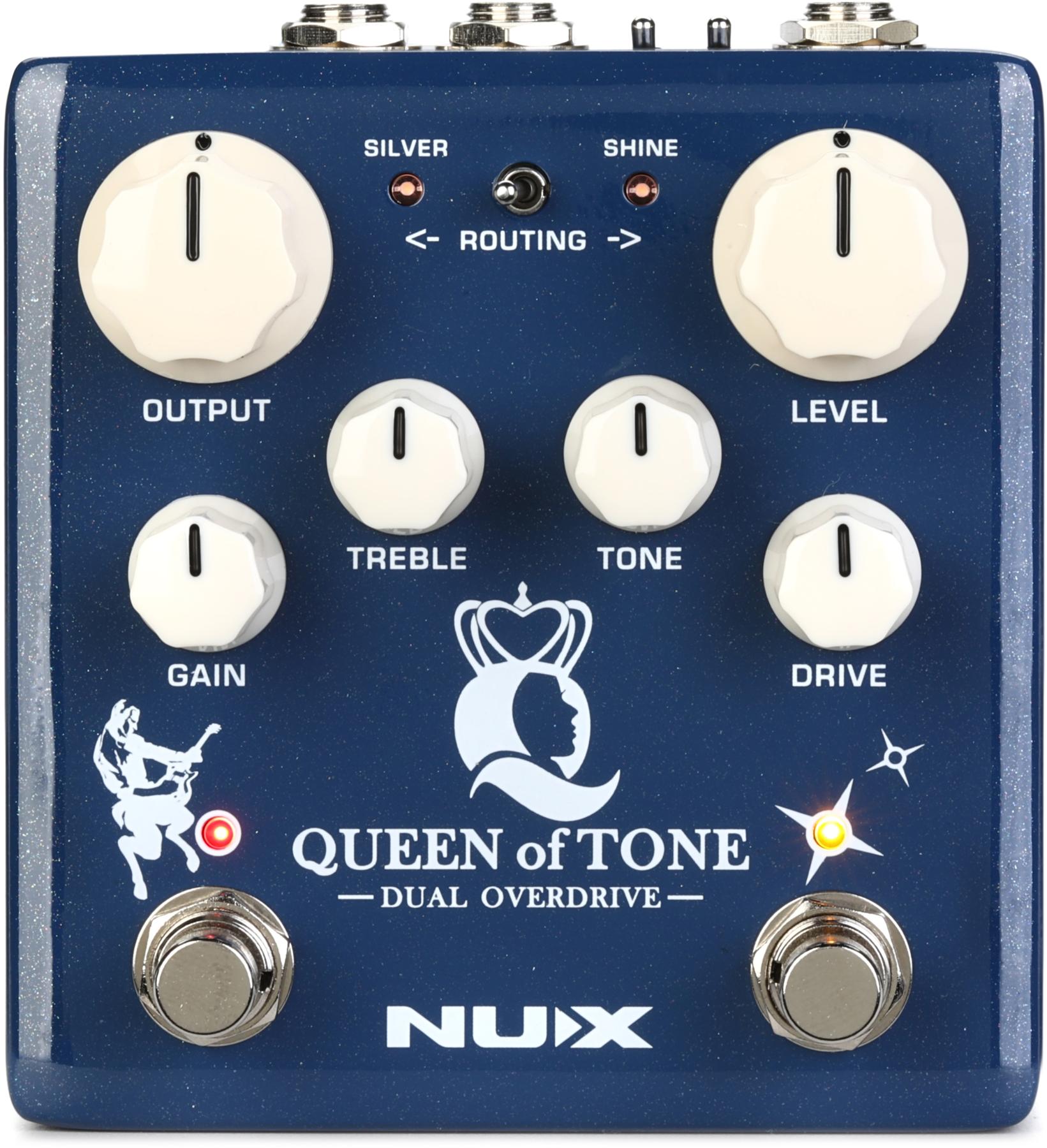Every year at this time we present our editors’ and reviewers’ choices of the best gear of the preceding 12 months. This year, it's a wide range of, well, just about everything that speaks to us as guitar players. Get ready to be impressed by this top-shelf selection of instruments, amps, and pedals.
Way Huge Stone Burner Sub Atomic Fuzz Pedal
WAY HUGE
Stone Burner
(January 2024)
Another offspring of the much-cherished Way Huge Atreides Weirding Module, the Stone Burner is effectively the octave-fuzz section from the Atreides—no small gift to players that found little use for that pedal’s modulation section. With the option to add as many as two sub-octaves to the super-wild fuzz, the Stone Burner is beastly. But creative players will find many strange and heavy synth-like and fractured sounds that transcend mere heaviness.
Marshall ST20C Studio JTM 1 x 12-inch 20-/5-watt Tube Combo Amplifier
MARSHALL
JTM ST20C Studio
(January 2024)
For a company so famously associated with bigness, Marshall downsizes quite gracefully. There is precedent for this, of course: The Marshall 18-watt is an all-time classic. But the 5881-powered JTM Studio ST20C mimics another classic entirely by assuming much of the sonic and tactile personality of the original Marshall JTM45. That means it has a knack for moving between American and British accents without sacrificing the ability to roar and bite that so many Marshall players savor.
Skreddy Pedals Skunk Drive Model 1606

SKREDDY
Skunk Drive Model 1606
(February 2024)
Skreddy’s Marc Ahlfs derives big-time inspiration from the sounds of Jimmy Page. In the form of the Skunk, Ahlfs focused on the dynamite and sometimes rather rude tones of Page’s Supro 1690T Coronado—the little beast behind Led Zeppelin I and the “Stairway to Heaven” solo. The Skunk certainly has those kinds of fangs. It’s midrange-y, a little compressed in the fashion of a Fender tweed, and readily ranges from boosted to almost-fuzzy fare.
$215 street, skreddypedals.comRead the Review
EarthQuaker Devices Zoar Dynamic Audio Grinder Distortion Pedal
EARTHQUAKER
Zoar
(February 2024)
The Zoar pedal will probably attract players that lean toward its more aggressive side. After all, reviewer Dave Hunter remarked that, “from razory and tight to flabby and bovine, there’s an entire world of high-gain, fuzzy distortion available.” But Hunter also found scads of lower-gain sounds that can be tuned for very specific needs using the powerful EQ and weight controls. The price is right too.
earthquakerdevices.com
Read the Review
MOOER Micro Looper II

MOOER
Micro Looper II
(February 2024)
This tiny budget box from Mooer should satisfy every casual-to-intermediate loop enthusiast. The Micro Looper II is a cinch to operate, with basic, intuitive controls and clear parameters. You don’t have to grapple with a maze of menus on a tiny screen, and the auto record function is a great remedy for slight timing discrepancies. With three banks of 16 save slots, the Micro Looper II has 48 total spaces for unlimited-layer, 10-minute loops. Time to get loopy!
$88 street, mooeraudio.com
Mythos The Fates

MYTHOS
The Fates
(March 2024)
If you got 90 percent of the way to the sound of an original Boss CE-2, you would still have a fine chorus on your hands. We would venture that Mythos did better than that with the Fates, though. With the addition of vibrato and increased depth range, they also made it more flexible than the Boss classic. The Fates also looks and feels fantastic inside and out. It’s well made and a fine way to cover the iconic chorus sounds you associate with the Smiths or the Pretenders—and go another step beyond.
$219 street, mythospedals.com
Gibson Falcon 5 7-watt 1 x 10-inch Tube Combo Amplifier
Falcon 5
(March 2024)
If you love the sound of vintage Gibson and Valco combos, but appreciate the clarity, quality, robust punch—and some of the functionality—of a modern boutique amp, this 10"-speaker-equipped gem, which can flip between 3 and 7 watts, could be your pearl. Delicious overtones hang in the air, the mids and lows are fat and present with just the right amount of sag, and that light, distant fog that colors the originals is supplanted by clean, well-defined tones. It’s also kickass with dirt pedals.
Meris MercuryX Modular Reverb System Pedal
MERIS
MercuryX
(March 2024)
The MercuryX, an update of the Mercury7, is an embarrassment of reverb riches. It’s a testament to the Meris engineering team that they programmed so many beautiful, haunting, inspiring reverb algorithms into just one box. Each algorithm can be modulated to infinity and beyond. And the interface does an impressive job of massaging what could be a complex operating experience. It ain’t cheap, but when you consider the wealth of reverb sounds, and the customizability of those sounds, the price tag isn’t quite so daunting.
Fishman Loudbox Micro 40-watt 1 x 5.25-inch Acoustic Combo Amp
FISHMAN
Loudbox Micro
(March 2024)
Featuring both instrument and mic channels (the former has knobs for 3-band EQ, gain, reverb, and chorus intensity as well as a phase switch), the bantamweight Fishman Loudbox Micro acoustic amp goes largely undetected at the end of a signal chain. It preserves critical brightness in fingerpicking, and keeps string separation intact when strummed. Slight drawbacks are that the chorus intensity knob only introduces significant warble from 7 o’clock to noon, and not a lot after that. Otherwise, this conveniently portable little amp should satisfy even purists.
Third Man Hardware Fuzz-a-Tron

THIRD MAN HARDWARE
Fuzz-a-Tron
(May 2024)
The Third Man take on a fuzz-pedal kit has just a few components—two transistors, four capacitors, and four resistors, to be exact—and such easy-to-follow instructions that the Fuzz-a-Tron sets a new benchmark in the entry-level kit market. The cool, wedge-shaped enclosure gives the pedal a retro vibe, and the Fuzz-a-Tron delivers a tone that matches, sizzling like a Fuzzrite, but with a less cutting treble and tight mids. It’ll scratch your pedal-building itch with just basic soldering requirements.
$75 street, thirdmanrecords.com
PRS MT 100 Mark Tremonti 100-watt Tube Amplifier Head
MT 100
(April 2024)
Mark Tremonti’s latest signature amplifier is something of a contrarian, given the downsizing trends in amp land. At 100 watts, it’s super powerful. But it also pulls off the clever feat of employing three channels while feeling streamlined and simple to use. The bells and whistles are few, but the MT 100’s ability to span Fender Twin Reverb-style clean tones and ripping high-gain lead sounds makes extras feel superfluous.
Electro-Harmonix Canyon Echo Delay Pedal
ELECTRO-HARMONIX
Pico Canyon
(April 2024)
There is little that is pico about the Pico Canyon’s performance. The filter control adds tone-shaping versatility, the 8-millisecond-to-3-second delay range is super wide, and the infinite repeats function effectively as a looper at times. It’s much more than just a utilitarian echo, too. And though its voice is pretty neutral in color, that means more headroom for the odd modulation, lo-fi, and ring-modulation-like effects that the pedal can yield via creative tinkering.
Electro-Harmonix Oceans 3-verb Reverb Pedal
ELECTRO-HARMONIX
Pico Oceans 3-Verb
(April 2024)
Seeking a reverb that’s tiny, practical, and maybe just a little wild? Well, the Oceans 3-Verb covers the first two by focusing on essentials and fundamentals, and the digital emulations of spring, plate, and hall reverbs are great. But in the event you need to get weird, there’s also an infinite reverb that works in the hall and plate settings, which is awesome for droning. Those interested in more extreme versions of the three voices will appreciate the 3-Verb’s capacity for mega-ambience at higher control settings.
Wren and Cuff Eye See '78

WREN AND CUFF
Eye See ’78
(April 2024)
Matt Holl’s lovingly executed Big Muff homages have traditionally focused on Ram’s Head and Sovtek versions. But the Eye See ’78 is a thrilling take on the V4 Big Muff, which was distinguished by the temporary switch to an op-amp-based circuit. Though the Eye See ’78 possesses all the monstrous charms of any classic Big Muff—mass, volume, and crunch—it has a mid-forward voice that is atypical of Big Muffs but still quite capable of leveling brick buildings.
$324 street, wrenandcuff.com
Pigtronix Cosmosis Stereo Morphing Reverb Guitar Effects Pedal Blue
PIGTRONIX
Cosmosis Stereo Reverb
(April 2024)
We commented that the Cosmosis evokes spaces measured in light years, and that’s not hyperbole. It can be dialed in to create big octave-up reverb textures that avoid the more cloying manifestations of those sounds. But it’s comfortable generating more modest and convincing amp- and room-like sounds too. A morph function enables players to readily move between these extremes, making this a very powerful tool for live performance.
PRS SE CE 24 Standard Satin Electric Guitar
PRS
SE CE 24 Standard Satin
(May 2024)
The Indonesia-built SE CE 24 Standard Satin probably could have been half the guitar it is and still be a ripping deal at $499. Construction quality is top-notch, the coil-splitting capacity makes it PAF-to-Stratocaster versatile, and the import version of PRS’ patented vibrato is rock steady. Players that like to eschew flash will be pleased to see a PRS in such a modest and understated guise.
Carr Bel-Ray

CARR
Bel-Ray
(May 2024)
As the Bel-Ray ably demonstrates, Steve Carr’s designs do not merely ape traditional American-style circuits. They are highly original and imaginative. And in this case, the amp bellows with a mighty English accent. The Vox AC15 and 18-watt Marshall are obvious touchstones here, and the EL84-powered Bel-Ray nails the spirit of those famously overachieving circuits. But it also employs a 3-way voice switch that moves between Vox, Hiwatt, and Marshall EQ gain profiles—yielding many more worlds of firecracker and crystalline tones.
$3,240 street, carramps.com
Aion FX Azimuth Dynamic Overdrive

AION FX
Azimuth Dynamic Overdrive
(May 2024)
As a first-time pedal builder, editor Jason Shadrick learned an incredible amount from building the Azimuth. It’s a take on the Hermida Zendrive, and by all accounts sounds extremely authentic. Aion’s documentation was impeccable, and the components were top notch. The real star is the voice control, which subtly crafts the low-end response. If those used prices for a Zendrive are out of reach, this should be your very next stop.
$79 street, aionfx.com
Warm Audio RingerBringer Ring Modulation Pedal
WARM AUDIO
RingerBringer
(May 2024)
Ring modulators are intrinsically out-there machines. And the Moog MoogerFooger MF-102 that inspired this Warm Audio homage was powerfully odd indeed. The sounds from the much-less-expensive RingerBringer are faithful to the beguiling and beautiful sounds of the Moog original. They can be scary, otherworldly, and downright weird, but also throbbingly atmospheric in the more conventional tremolo-like modes. And at just $219, you won’t have to worry too much about taking a chance on an outlandish musical device outside your comfort zone.
Beetronics FX Nectar "Tone Sweetener" Overdrive/Fuzz Effects Pedal
BEETRONICS
Nectar
(May 2024)
You could categorize the Nectar as a very practical fuzz or a fuzzy overdrive. But the important thing is that it can generate any one of a hundred shades of gain between extremes on the distortion spectrum. And no matter how you classify it, it’s exceptionally versatile. The fuzz tends toward smooth and creamy, but its expansive gain range means you can also summon the throaty crunch of a MXR Distortion+, or a mild dollop of boost, just as easily.
Death By Audio Octave Clang

DEATH BY AUDIO
Octave Clang
(June 2024)
Octave fuzz and Death By Audio are a natural match. In Dungeons & Dragons terms, they both are of chaotic alignment (we won’t pass judgment on the good or evil part). And in true Death By Audio style, the Octave Clang takes a most idiosyncratic and individual approach to an already anarchic effect. The fuzz side of the Octave Clang is direct and hard-hitting, very much in the vein of simple mid-’60s fuzz boxes. And while the octave can add traditional Hendrix textures, it is also responsive to the personalities of different guitars and guitar-control settings in a way that yields tankards full of odd textures.
$225 street, deathbyaudio.com
Silktone Overdrive+

SILKTONE
Overdrive+
(June 2024)
It’s hard to think of another pedal that so successfully swirls the line between overdrive, distortion, and fuzz. And that lack of singular focus is exactly what makes the Overdrive+ such a standout. If you come armed with a robust clean tone, this pedal alone can turn your amp into a 3-channel gain machine that hits all the marks for dirty, crunchy tones. The Overdrive+ makes a strong case for itself as the only gain device you’ll need on your pedalboard.
$269 street, silktone.org
ESP LTD M-1001 Electric Guitar - Charcoal Metallic Satin
ESP LTD
Deluxe M-1001
(June 2024)
Reviewer Joe Charupakorn was struck by the straight-ahead, rather wicked personality of the M-1001. Sleek, stripped-down (save for the subtly fancy gold hardware) and built for speed, it’s tailor-made for aggressive styles of music. Twenty-four frets and a 12"-16" radius mean a lot of runway for fast, expressive players. The Floyd Rose 1000 vibrato helps, too. But nothing reflects the M-1001’s brutish focus more than the single, ferocious Fishman Fluence pickup and absence of a tone knob—a direct line to raging!
Walrus Audio Fundamental Series Ambient Pedal
WALRUS
Fundamental Ambient
(June 2024)
With slider controls that evoke early ’70s JEN stompboxes, three reverb voices, and a very approachable $129 price tag, the Walrus Ambient is a fun way to delve into the realm of super-big reverb spaces without risking an equally big investment. The low price doesn’t mean Walrus skimped on the quality, however. It’s a sturdy thing. But the slider controls invite a more interactive approach to using the pedal, which unlocks even more reverb treats.
Taylor 117E Grand Pacific Acoustic-Electric Guitar Natural
TAYLOR
117e
(July 2024)
Taylor’s slope-shouldered Grand Pacific shape echoes that of classics like the Gibson J-45, and, at just less than 900 bucks, it may be one of the most budget-friendly ways to experience the comfort and classy looks of a slope-shoulder dread. Much of that value, of course, has to do with Taylor’s customary excellent playability. And though it’s more midrange-forward than more upmarket, bass-rich versions of the Grand Pacific, it offers a tone palette that will soothe and excite strummers and fingerstylists.
Supercool Pedals Zig-Zag

SUPERCOOL
Zig-Zag
(July 2024)
The analog, BBD Zig-Zag is a dead-simple chorus and vibrato. With just two controls—rate and depth—plus a toggle switch to go between the two effects, it doesn’t offer the sort of tonal customization some players will demand, but it more than makes up for it in clarity and fidelity. At both subtle settings and vertigo-inducing extremes, the Zig-Zag is remarkably clear and present, thanks in part to a small dB boost. It’s an all-analog blast.
$189 street, supercoolpedals.ca
Keeley Blues Disorder, Angry Orange, and Super Rodent
Blues Disorder, Angry Orange, and Super Rodent
(July 2024)
If these pedals sound a little like monsters, well, perhaps it’s because they are all based on a very Frankensteinian design concept: stuff a box with two drive circuits, then enable the user to move interchangeably between the clipping and EQ sections from each. In the case of the Blues Disorder, the combination is one of circuits derived from the Marshall BluesBreaker and Fulltone OCD. In the Angry Orange, it’s the more unconventional union of Sovtek Big Muff and Boss DS-1. And the Super Rodent mashes up the Pro Co RAT and Boss Super Distortion. If you can’t find a distortion tone to love here, maybe you should pivot to the piccolo.
Victory Amplification The Deputy 25-watt Tube Amplifier Head
VICTORY
The Deputy
(August 2024)
At 25 watts, and with a pair of EL86s driving the works, the Deputy deviates from the two-EL84, 15-watt template that is something of a standard in the low-to-medium-wattage English-amp realm. But with a flexible EQ, bright switch, and EL86s running in fixed bias, the Deputy will happily meet players in the middle of the Atlantic—spanning clean and crunchy AC15-style tones as well as nice black-panel Deluxe Reverb sounds when you scoop the midrange a bit.
Fender 70th-anniversary American Vintage II 1954 Stratocaster
FENDER
70th Anniversary American Vintage II 1954 Stratocaster
(August 2024)
Any nice Stratocaster is a study in balance—some might even say design perfection. The 70th Anniversary American Vintage II 1954 Stratocaster is a reminder of just how amazing the design was from the get-go. Needless to say, vintage details abound on the AVII 1954 Strat. Even the headstock is the more curvaceous early incarnation of the one that became iconic. The chunky 1954 C neck profile is a hefty but comfortable alternative to the deep-V necks from the AVII 1957 Stratocaster, and the pickups readily dish hot or silky-and-sweet tonalities.
$2,599 street, fender.com
Boss Katana Artist Gen 3 1 x 12-inch 100-watt Combo Amplifier
BOSS
Katana Artist Gen 3
(August 2024)
With a street price of just $599, the Boss Katana Artist Gen 3 makes no bones about its intent to grab the tones-per-dollar title belt. The 100-watt, 1x12, digital heavy-lifter can play the role of a stage amp, home practice rig, or foundation for your recording rig. And with the ability to bridge brown-sound saturation and clean sounds of many colors—all with sometimes startling authenticity—the Artist Gen 3 is a mighty, and mighty-affordable, toolbox for the player that likes scads of sounds in one place.
$599 street, boss.info
IRIS MS-00

IRIS
MS-00
(August 2024)
The Vermont builder’s Gibson L-00-inspired model was created in collaboration with vintage-Gibson expert Mark Stutman of Folkway Music. Exuding a relaxed, down-to-earth retro vibe, the MS-00 has a simple aesthetic. There’s no pore filler on the backs and sides, which helps with the visual vibe and probably gives it more resonance as well. This is a touch-sensitive, midrange-focused instrument, and at $2,450, this Iris puts a high-end luthier-crafted experience within reach.
$2,450 street, irisguitarcompany.com
PRS S2 Vela Electric Guitar - Scarlet Sunburst
PRS
S2 Vela
(September 2024)
A lot of folks think the Vela is the prettiest PRS body profile. But even if it looked like a ping-pong paddle, there’d be no denying just how much the S2 Vela does well. The US-made DS-01 and Narrowfield pickups that distinguish this newest incarnation of the S2 Vela can deliver Telecaster twang, Stratocaster blues wail, and crunch tones with uniform ease. And like just about every PRS, the quality is tip-top.
Universal Audio UAFX Lion '68 Super Lead Amp Pedal
UAFX
Lion ’68
(September)
If you haven’t dabbled in amp modeling much, it would be easy to mistake the Lion ’68 for a simple Marshall-in-a-box pedal and wonder about the near-$400 price. But the Lion’s ability to emulate Marshall size and dynamite responsiveness on a desktop or pedalboard goes way beyond merely suggesting Marshall-ness. The Lion ’68 often sounds and feels uncannily like the real thing, and the ability to further shape your tone with virtual amp, cab, and room changes, you’ll be knocked flat not just by the power on tap, but the variation in these sounds.
Warm Audio Warm Bender Fuzz Pedal
WARM AUDIO
Warm Bender
(October 2024)
The original Tone Bender MkII is not only one of the most bitchin’ sounding fuzzes ever, it’s also among the coolest to look at. Warm Audio held onto the essential style of the very-large original while downsizing its dimensions. But the real treats here are the three switchable voices that move between NOS 75, NOS 76, and silicon transistor modes, which offer three distinct flavors of one of the fuzz world’s most fabulous colors.
JAM Fuzz Phrase Si

JAM
Fuzz Phrase Si
(October 2024)
Though it plays second fiddle in some respects to its germanium big brother, the silicon Fuzz Face is a mighty buzz bomb that’s lent menace and muscle to some of Jimi’s and Gilmour’s finest moments. Like the original Fuzz Face, this JAM homage takes the place of a much-loved germanium predecessor. But this top-quality, silicon version of the circuit is a lovable amalgam of simplicity and swagger.
$229 street, jampedals.com
Cusack Project 34 Selenium

CUSACK
Project 34 Selenium Rectifier Pre/Drive
(October 2024)
The low-gain overdrive known as the Project 34 is named for selenium’s number on the periodic table of elements. But you won’t need to know what’s inside to discern the smooth, dynamic response in the overdrive that reviewer Dave Hunter called “a very organic gain stage that just makes everything sound better.”
$240 street, cusackmusic.com
Strymon BigSky MX Reverb Pedal
BigSky MX
(October 2024)
We don’t often see new stomps that clock in at 679 bucks. But the BigSky MX is no ordinary reverb. An 800 MHz tri-core ARM processor with 32-bit floating-point processing makes the BigSky MX crazy-powerful. There are new sounds galore, and the programming capabilities and flexible connectivity are impressive. It might be overkill for traditionally minded guitar players and take three lifetimes to explore its every capability, but the BigSky MX could be a bonanza for guitarists that stretch their expression to the realms of sound design.
Electro-Harmonix x JHS Lizard Queen Octave Fuzz Pedal
EHX/JHS
Lizard Queen
(October 2024)
At $99 street, the Lizard Queen octave/distortion is a bargain and a magic-carpet ride back to the golden era of fuzztone. Its three controls make it easy to dial in classic sounds that can also be highly reactive to guitar volume. While many fuzzes can get lost in the blast of a full band, the Lizard Queen—with its impressive output—will have no trouble slithering to the front of the mix.
J. Rockett Audio Designs El Hombre Overdrive Pedal
J. ROCKETT
El Hombre
(October 2024)
The El Hombre delivers on its promise of the Rev. Billy F. Gibbons’ tone. But how much you dial that in is a matter of taste, because this pedal is a highly flexible overdrive that allows you to determine how many shovels of dirt you want to spread over your sound. Compared to a lot of other ODs, it’s a little expensive. But if you’ve been searching for that Tejas magic, and more, the El Hombre might be what you’ve been yearning for.
EarthQuaker Devices Time Shadows II Subharmonic Multi-delay Resonator Pedal
EARTHQUAKER/DEATH BY AUDIO
Time Shadows II
(October 2024)
If weirding’s your thing, this pedal’s for you. The Time Shadows Multi-Delay Resonator combines three delay voices with filters, fuzz, phasing, shimmer, swell, and subharmonics. The challenge is working the cascading aural whirlpools and dinosaur choirs into song arrangements, but editorial director Ted Drozdowski heard how the pedal could be used to create unique, wonderful pads or bellicose solos after just a few minutes playing. If you’d like to easily sidestep the ordinary, you’ll find spelunking this stomp’s cavernous possibilities worthwhile.
Red Panda Radius Ring Modulator/Frequency Shifter Pedal
RED PANDA
Radius
(October 2024)
The Radius delivers ring modulation and frequency shifting: a heady combo that’s not for the faint of heart! But if you’re brave enough to dive in, it’s impressively easy to find your way around such a complex effect. Classic ring-mod tones are the jumping-off point for oodles of bold new sounds generated by envelope and waveform-controlled modulation and interaction. The Radius would be at home on any wide-eyed experimenter’s pedalboard, or make a powerful studio accessory.
JHS Hard Drive Distortion Pedal
JHS
Hard Drive
(October 2024)
Starting out as an homage to an Ibanez SM7 Smash Box, the JHS Hard Drive evolved into a unique, original circuit designed for ’90s high-gain oomph. With a streamlined 6-knob control panel featuring 3-band EQ as well as volume, mid frequency, and drive, it delivers massive bottom end at even the lowest drive setting. With drive all the way up, you’re in for all-out chaos. The effective and powerful EQ introduces more range than the average heavy pedal. What this box lacks in low- and mid-gain options, it makes up for in an excellent array of modern high-gain variations.
Wampler Mofetta Overdrive And Distortion Effects Pedal
WAMPLER
Mofetta
(October 2024)
A riff on Ibanez’s cult classic, the MT10 Mostortion, the Wampler Mofetta replicates its forefather’s clipping-diodes circuitry, but offers a texture switch to toggle between that and MOSFET gain stages. It captures the vibe of edge-of-amp-breakup low-gain perfectly. On the first setting, it has expansive headroom where you can find a lot of bold, cutting tones, while classic rock and early metal are accessible on the MOSFET setting. Great touch sensitivity and the texture switch set this pedal on a path to more aggressive spaces.
SoloDallas Orbiter Fuzz

Orbiter Fuzz
(November 2024)|
Inspired by the 1966 Dallas Arbiter Fuzz Face, the Orbiter stings and sings like a germanium Muhammad Ali. It delivers over-the-top fuzz, yet allows core tones to emerge. The Orbiter also generates smooth, light distortion that sustains beautifully when you use an easy touch, punches through a live mix with its impressive gain, and generates dirt voices from smooth to sputtering, via the bias dial. For some, this might be the last stop in the search for holy grail Fuzz Face-style sounds.
$249 street, solodallas.com
Epiphone 1963 Firebird I Electric Guitar - Silver Mist
1963 Firebird I
(November 2024)
This high-quality reissue of a Gibson classic looks, feels, and sounds impressive, indeed. And though it’s a one-pickup guitar, the Firebird mini humbucker makes its voice surprisingly versatile and powerful. The simplicity and elegance of its look, streamlined controls, clean surface, and light weight made the I a joy to play, especially with the treble rolled to near-zero. There, early Clapton-esque tone is a cinch to find, and for blues and jazz licks, the warmth and clarity are delightful.
PRS DGT 15 David Grissom 15-watt Tube Head - Blonde Tolex
PRS
DGT 15
(November 2024)
A more club-friendly take on the PRS DG Custom 30, the single-channel, reverb-and-tremolo-equipped DGT 15 is built with two EL84s, three 12AX7s, and one 12AT7. Its 3-way bright, boost, and master volume switches add an impressive range of colors and gain contrasts, with a core tonality in the ’60s black-panel Fender camp. Without boost, you have headroom up to the 3 o’clock volume level before it starts breaking up; when boosted, the satisfying saturation skirts modern overdrive sizzle. This amp scales new heights of tone versatility at an accessible price.
EarthQuaker Devices Silos Multi-generational Time Reflection Delay Pedal
EARTHQUAKER
Silos
(November 2024)
Simple, streamlined, and inexpensive, the digital Silos features six presets, tap tempo, one full second of delay time, and three voices—two of which are styled after bucket-brigade and tape-delay sounds. You won’t often see these features all together in a delay at this price. But that they all sound so exceptionally good is what makes the Silos special.
Read the Review ONLINE VERSION NOT YET PUBLISHED
Warm Audio Pedal76 Analog FET Compressor Pedal
WARM AUDIO
Pedal76
(November 2024)
Warm Audio already makes a well-regarded, ultra-affordable Urei 1176 clone. But they also put that experience to work here in service of honoring Origin Effects’ own compact homage to the 1176, the Cali76. Like a real Urei 1176 and the Cali76, the Pedal76 adds life, spark, and octane to the blandest amp tones and gracefully walks the line between adding sustain and not sacrificing too much in the way of dynamics or the essence of your rig.
You can find reviews of the December 2024 Premier Gear Award Winners—Death By Audio’s Bass War, Universal Audio’s Enigmatic ’82 Overdrive Special, Squier’s Affinity Telecaster Thinline, L.R. Baggs’ AEG-1 guitar, Positive Grid’s Spark 2, and Warm Audio’s WA-C1—elsewhere on premierguitar.com.


























































